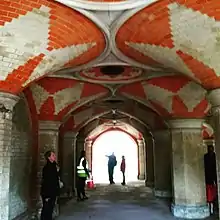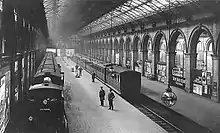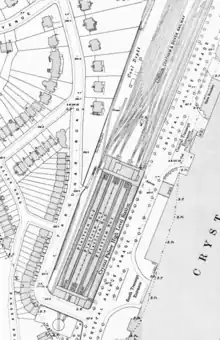Crystal Palace (High Level) railway station
Crystal Palace (High Level) was a railway station in South London. It was one of two stations built to serve the new site of the Great Exhibition building, the Crystal Palace, when it was moved from Hyde Park to Sydenham Hill after 1851. It was the terminus of the Crystal Palace and South London Junction Railway (CPSLJR), which was later absorbed by the London, Chatham and Dover Railway (LCDR). The station closed permanently in 1954.
Crystal Palace (High Level) | |
|---|---|
 | |
| General information | |
| Location | Crystal Palace, Dulwich England |
| Coordinates | 51.4214°N 0.0785°W |
| Grid reference | TQ337709 |
| Platforms | 6 |
| Other information | |
| Status | Disused |
| History | |
| Original company | Crystal Palace and South London Junction Railway |
| Pre-grouping | London, Chatham and Dover Railway South Eastern and Chatham Railway |
| Post-grouping | Southern Railway British Railways |
| Key dates | |
| 1 August 1865 | Opened as Crystal Palace (High Level) |
| 1 November 1898 | Renamed Crystal Palace High Level and Upper Norwood |
| 1 January 1917 | Temporarily closed |
| 1 March 1919 | Reopened |
| 9 July 1923 | Renamed Crystal Palace High Level |
| July 1925 | electrified |
| 22 May 1944 | Temporarily closed |
| 4 March 1946 | Reopened |
| 20 September 1954 | Station closed to passengers |
History
Origins

In 1860 the LCDR had a route from Beckenham Junction to Victoria via the existing Crystal Palace station (later known as "Low Level"), but this was owned and operated by the rival London, Brighton and South Coast Railway (LBSCR). To capture traffic from the LBSCR the LCDR promoted the CPSLJR to construct a branch from Peckham Rye on the South London Line via Nunhead to a new terminal station above the Crystal Palace park.
The line, and the terminus only, opened on 1 August 1865. It was on the southern boundary of the Hamlet of Dulwich division of the ancient Civil Parish of Camberwell St. Giles.[note 1]
Features

The station was designed by Charles Barry Jr. as a lavish red brick and buff terra cotta building. It was excavated into the ridge below Crystal Palace Parade, approached from the north through the 439 yards (401 m) Paxton Tunnel,[1] requiring major engineering works. There were subway exits leading under Crystal Palace Parade into Crystal Palace Park, linking the station directly with the palace. The subway was a vaulted and tiled chamber resembling a Byzantine crypt; it was designed and built by cathedral craftsmen from Italy.
The building was a fine example of High Victorian architecture with high brick side- and end-walls and a glass and iron trainshed roof. It had square towers at each corner, each topped with four short spires, and passenger concourses above the tracks at each end with booking offices, refreshment rooms and waiting rooms. One half of the station was intended for first class passengers, who were given segregated access into the central transept of the palace.
The trainshed was divided lengthways into two cavernous spaces separated by a brick-arch arcade, each side having two tracks with wooden platforms. The inner track on each side had two platform faces to support mass arrivals.

At the exit from the tunnel the two running lines fanned out into four platform tracks, with eight sidings and a long headshunt on the right and two more sidings on the left. In addition to the usual coal depot, the sidings provided stabling for spare engines and coaching stock to handle the expected surges of traffic during big events. The platform roads entered the north end of the trainshed via separate portals. At the south end, instead of a typical arrangement of buffers and engine release roads the four platform tracks passed through a second set of apertures to a turntable, allowing for fast turning of engines to run round their coaches.

Decline and closure
The line was one of the first of the former South Eastern and Chatham Railway to be electrified by Southern Railway, under "South Eastern Electrification – Stage 1" in July 1925.[2] But after the Crystal Palace was destroyed by fire in 1936, traffic on the branch declined. During World War II the line was temporarily closed after bomb damage. Although temporary repairs were made and the line subsequently reopened the decline in traffic and a requirement for heavy reconstruction work led to the decision to close the station with the branch on 20 September 1954, although it was not demolished until 1961.
| Preceding station | Disused railways | Following station | ||
|---|---|---|---|---|
| Upper Sydenham Line and station closed |
British Railways Southern Region Crystal Palace and South London Junction Railway |
Terminus |
Surviving structures
Although the site of the station was developed for housing in the 1970s, the retaining walls below Crystal Palace Parade and the ornamental portal of Paxton Tunnel to the north are still readily visible.[note 2] The brickwork fits exactly although the ground level is raised. The subway and an adjacent courtyard survived the 1936 fire and was used as an air raid shelter during World War II. It is now a Grade II* listed building.[3] Although the subway is sealed off, it is sometimes opened to allow organised visits by "Friends of Crystal Palace Subway".

Southwark Model Railway Club have built a scale model of the station.[4]
The "train entombed in the tunnel" myth
There is a rumour that, in one of the sealed tunnels in the area, an engine or carriage remains hidden collecting dust. Another version of the story, popular among local schoolchildren, claims that the High-Level station was closed because a commuter train was trapped by a tunnel collapse, entombing the passengers, who remain there to this day.[5]
These stories are an example of the persistence of local urban legend. The story of the entombed train was apparently current in the 1930s. Back then it referred to the abandoned 1860s pneumatic railway on the north side of the grounds of Crystal Palace Park.[5]
Most traces of this had almost certainly been destroyed by the building works for the 1911 Festival of Empire, but there was an unsuccessful archaeological dig for the train sponsored by the BBC's Nationwide current-affairs programme in the 1970s.[5]
Notes
- Following the creation of the LCC it was in the Metropolitan Borough of Camberwell, and subsequently the London Borough of Southwark.
- This appears in the Ken Russell film of 1958 titled "Amelia and the Angel".
References
- "Paxton Tunnel". Subterranea Britannnica.
- "Electric Railways". Stendec Systems. 2007. Archived from the original on 28 September 2007. Retrieved 1 February 2007.
- Historic England. "Subway, Vestibule, Terrace and Stairs to the Crystal Palace (1385457)". National Heritage List for England. Retrieved 13 January 2020.
- "Southwark Model Railway Club layout". 9 February 2014.
- Crystal Palace High Level & Upper Norwood Station at Subterranea Britannica
Further reading
- Crystal Palace (High Level) and Catford Loop by V Mitchell & K Smith, Middleton Press, 1991
- The Railway through Sydenham Hill Wood, From the Nun's Head to the Screaming Alice by Mathew Frith, The Friends of the Great North Wood and London Wildlife Trust leaflet 1995
- London's Local Railways by A A Jackson, David & Charles, 1978
- The Crystal Palace (High Level) Branch by W Smith, British Railway Journal 28, 1989
External links
- London's Abandoned Stations – Crystal Palace branch
- Crystal Palace High Level & Upper Norwood Station at Subterranea Britannica
- Interior of the VIP entrance to the Exhibition
- Friends of Crystal Palace Subway
